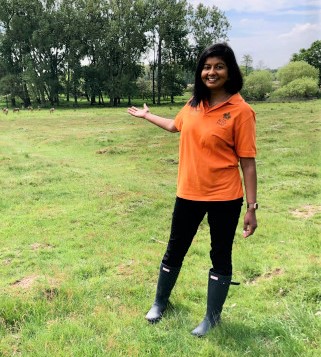Ranger photo courtesy of Metro online
Help Nature Thrive
On 9 June, The Royal Parks launched a campaign called ‘Help Nature Thrive’ across all the Royal Parks. The campaign will run throughout the summer, with the key objectives of:
- Reminding visitors that the parks are important refuges for nature, and encouraging them to adopt behaviours to help nature thrive in the parks
- Raising awareness of the threats to biodiversity in the parks (ie climate change, increased visitor footfall, spread of animal and plant diseases etc)
- Publicising what The Royal Parks is doing to help nature in the face of these challenges
As part of the campaign, visitors to Richmond Park, will also be reminded to keep a minimum of 50m from the deer, and to protect their natural way of life by not feeding or touching the deer.
See here for more details
Volunteer Events Team Leader needed for Fairs and Open Days
For a long time “PJ” Greeves led the Regular Events team hosting FRP’s stand at local village fairs and the Richmond Park Open Days. With PJ’s sad passing in April, we need a new team leader. FRP has not had a presence at such events for a while, but we hope to start again before long – and once again members/potential members will be able to meet us face to face at events like the Richmond May Fair.
The role is to organise FRP’s attendance at such events: booking the pitch; drawing together a small group from the existing Regular Events team; and with them rigging-up the stand (and any materials) and manning the stand on the day. Note that this role is about Regular Events, not one-off big events and talks. If you’re interested, please email Nick at [email protected] or call him on 07831 271 95
Stalking, talking and wearing orange – a day in the life of a Richmond Park ranger
Read this recent Metro online news article about what it’s like to be a Richmond Park Ranger.
Read here
MP fined for allowing dog to worry deer
An MP whose puppy caused a stampede by chasing a herd of 200 deer in Richmond Park has been fined. He admitted losing control of his 11-month-old Jack Russell, Pebble, during a walk with his family on 20 March. He was charged with causing or permitting an animal to chase or worry another animal in a royal park and was told to pay a fine and costs totalling £719.
See full details in BBC News article.
Visitor Centre July Sale and extended opening hours
The Visitor Centre is now back to its usual opening times of 7 days a week, Covid restrictions and volunteer availability permitting.
Look out for recent arrivals and special offers:
- Pollen enriched Richmond Park Honey – especially good for locals who suffer from hay fever. £10.50
- Newly published RSPB ID spotlight guides £4.50 on Garden Birds, Woodland Birds, Butterflies and Bees, to mention a few.
- Stojo collapsible cups £6.00 were £9.00
- Pad blocks £2.00 were £3.50
- Singing greeting cards £2.50 were £4.50
- Other greeting cards £1.50 were £2.00
- Richmond Park Mugs £5.00 were £6.50
- RSPB birds (Cuckoo and Bullfinch) £2.50 were £6.00
- Plus offers on various other children’s items
Richmond Park Walks with Remarkable Trees
The first and second sets of our very popular self-guided tree walks are now at the Visitor Centre for £5 each set of 4 walks.
Discover the diversity and majestic beauty of some of the Park’s most interesting trees and also have a good walk in areas you may not otherwise get to see. All the walks are circular routes starting from a car park and between 2 and 5km long. Each walk is in its own easy-to-use 12-page booklet with many helpful photos. We have received lots of excellent feedback: “Brilliant, well written, superbly laid out, good levels of information”; “Following the trails and learning so much from them has honestly kept us sane”. Read more
Guided Walks
Our Guided Walks programme returned in June and will now take place the first Saturday each month until the end of the year.
7th August Kingston Gate car park
4th September Roehampton Gate car park
See full programme details.
Spring Tree Photography competition results
We are pleased to announce the results of the Friends’ Spring Tree Photography competition. See the winning photos plus the short and long listed photos.
The WINNER is Kasia Ciesielska-Faber who captured a magical moment with trees in the rising sunlight and mist around Pen Ponds. instagram.com/kasia.c.faber/
The runner-up is Nigel Attenborough with a dramatic panorama nigelattenboroughphotography.com
The 3rd placed photographer is Cath Gothard with trees on the banks of Beverley Brook @cathgothardphotography
Congratulations to all three as well as to the short and longlisted photographers.
All photos are the copyright of the photographer.
This is the last of the Friends’ four seasonal tree photography competitions.
Richmond Park film latest
The Friends’ Richmond Park film had over 40,000 views in June. It has now been seen over a third of a million times! See it here
Deer fawn knocked down and killed by cyclist
After a fallow deer fawn was hit and killed by a cyclist in Richmond Park, on 12 June the Royal Parks Police issued a reminder to visitors to take extra care during deer birthing season. The young deer was knocked down on Broomfield Hill which runs along the south-east edge of the park. The cyclist contacted the Royal Parks to report the incident. More details.
Just passing through!
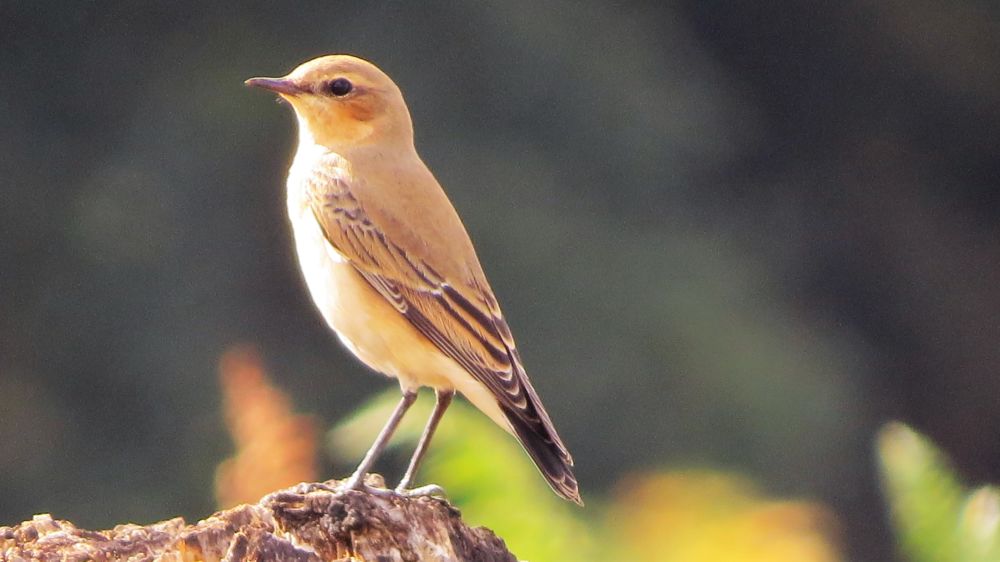
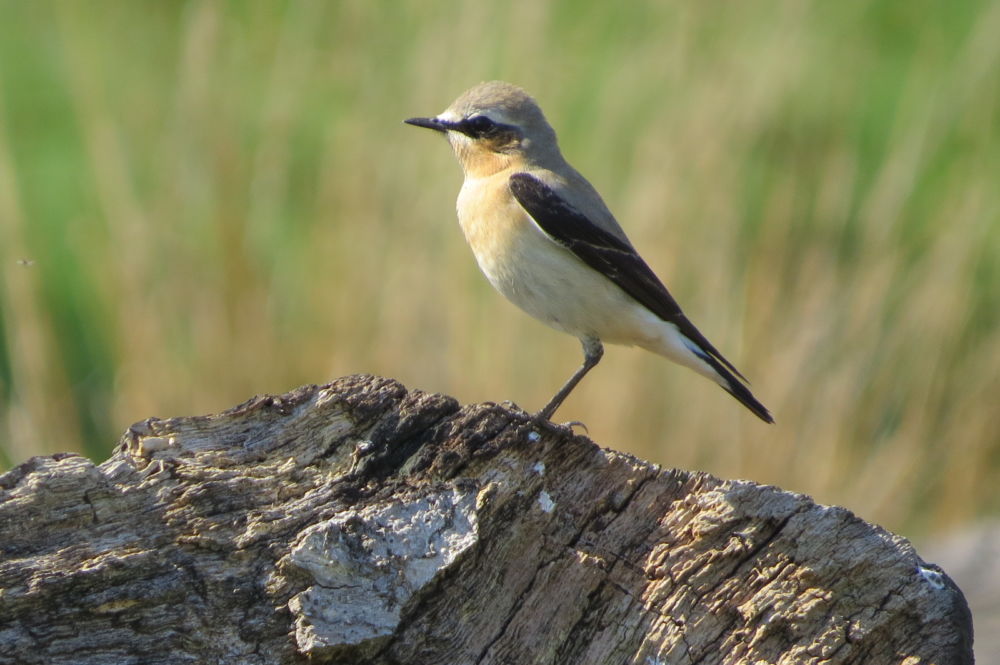
Female Wheatear Male Wheatear
This Spring saw a remarkable number of Wheatears pass through the Park on passage to their breeding grounds elsewhere in the country. Richmond Park must be one of the best places in South London and Surrey to see Wheatears. The dapper looking males and more sedately plumaged females arrive in this country from March onwards, travelling from their wintering quarters in Africa to their summer breeding grounds further north and west in Britain. (Photos by Nigel Jackman).
Read more
A rare visitor
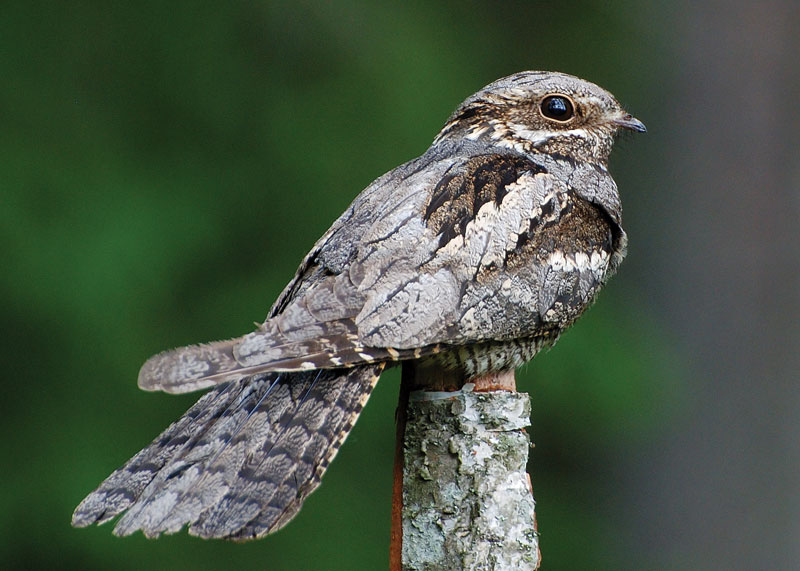 A surprise visitor to the Park last month was a male Nightjar, a nocturnal bird with pointed wings and a long tail, similar in shape to a cuckoo or kestrel. Nightjars roost secretively in the day, but can be seen hawking for insects at dusk and at dawn. They are not uncommon in parts of Surrey, but within the wider London recording area there are rarely more than two if any reports each year. Whereas Nightjars once bred here many years ago, this was only the sixth recorded visit in the Park in the past two decades. The bird was observed and heard on several evenings after its initial discovery before apparently moving on. You can read more about the species, and in particular listen to its unique and amazing churring call. (Photo by Britannica).
A surprise visitor to the Park last month was a male Nightjar, a nocturnal bird with pointed wings and a long tail, similar in shape to a cuckoo or kestrel. Nightjars roost secretively in the day, but can be seen hawking for insects at dusk and at dawn. They are not uncommon in parts of Surrey, but within the wider London recording area there are rarely more than two if any reports each year. Whereas Nightjars once bred here many years ago, this was only the sixth recorded visit in the Park in the past two decades. The bird was observed and heard on several evenings after its initial discovery before apparently moving on. You can read more about the species, and in particular listen to its unique and amazing churring call. (Photo by Britannica).
Quarterly Newsletter – online option
Friends members who receive their Spring, Summer and Autumn Newsletters as a printed booklet, may prefer instead to receive them as a pdf document that can be downloaded. If so, please email Chris Mason at: [email protected]
You can see past issues of newsletters as pdfs here on our website
Richmond Park Diary – July 2021
©TRP
Oak Processionary Moth
July is that time of year when the Oak Processionary Moth poses a higher risk to the public. The caterpillars are now sufficiently mature to have toxic hairs and they process around the tree. They occasionally come low enough to be within touching distance of the public and therefore most at risk – especially on trees near busy areas. They will soon stay in the nests and pupate. Careful surveying of the park by our volunteers will continue into July to locate nests which are then removed by specialist operatives using protective clothing and equipment. If you come across the caterpillars or their webbed nests, please do not touch them and keep children and pets away.
New coffee kiosk
A new coffee kiosk at Kingston Gate opens on or soon after 4 July. The small wooden hut used to be a gate keepers hut in the days prior to mobile phones but has largely been redundant for at last 30 years. It was fitted with an electrical and water supply and was relatively easy to refit. The window has been enlarged slightly and now opens upward to create a serving hatch and the internal dimensions are just right for a coffee machine, and ice-cream maker and limited range of snacks and cold drinks. Whilst it is an initial trial for 12-18 months, we anticipate that the range of refreshments will meet customers’ needs and generate enough sales to keep the facility open. Sales of refreshments also contributes revenue to pay for general upkeep of the park.
Bracken control
Bracken is a fern that spreads by underground ‘rhizomes’ gradually increasing in area every year. It shades out other species and becomes a dense monoculture that compromises the wildlife value of the park. Left unchecked, bracken would take over the park’s grassland by about 1-2 hectares a year. Starting in July, the Parks Shire Horse team roll large areas of bracken to crush the stems and weaken the plant. Over time the bracken becomes increasingly smaller and space and grassland is re-created.
Contractors also control bracken by spraying herbicide in areas that are more difficult for the horses to work. The herbicide used only affects ferns and is not harmful to people or animals. The work is approved and funded by Natural England (the Government Agency for wildlife conservation). Finally, we also cut bracken and collect the ‘arisings’. The primary purpose of this is to produce a mulch that is suitable for use in Isabella Plantation and the national collection of azaleas as a replacement for peat. The repeat cutting also helps to reduce the vigour of bracken, which is a secondary benefit.
Ragwort
The management of Ragwort divides opinion. Whilst there are 3 types of Ragwort that are almost indistinguishable from each other, only Common Ragwort is poisonous to livestock if consumed in large quantities. Horse owners therefore need to eradicate Common Ragwort from grazing land which is a herculean task if one or two plants are left to spread seeds. However, in Richmond Park Ragwort offers a valuable nectar source where few other large flowers survive the browsing of the deer. The Royal Parks tries to strike a balance by only removing some plants from key locations such as bridleways. Ragwort is valued in the Park, but excessively large, dense stands are ideally removed after they have flowered but before they have set seed.
July in the Isabella Plantation
©TRP
Flowering and Shrubs
Large, late flowering rhododendrons can be found in the south section of the garden, between the stream from the Still Pond and the main central stream. They have pink and white fragrant flowers and include many hybrids of Rhododendron auriculatum. Many rhododendrons are now producing handsome new leaves. These are often covered with a soft felt layer, which is white or ginger, and known as ‘indumentum’. In the secluded lawn to the south of Thomson’s Pond the first giant flowers of the Magnolia grandiflora are set amongst glossy evergreen leaves. They have thick fleshy cream petals and a delicious citrus scent. Clethra barbinervis with its long racemes of white fragrant flowers can be found on the path leading from the Top Gate leading down towards Bluebell Walk, near the entrance to Wilson’s Glade.
Heather Garden
Look out for the “Button Bush”, Cephalanthus occidentalis, set back from the path leading to the Bog Garden. This shrub bears creamy-white flowers in small globular heads, which are very attractive to butterflies.
Bog Garden
In the Bog Garden the tall yellow spires of Ligularia przewalskii are set against a backdrop of bamboo, and the Gunnera manicata spreads its giant prickly leaves. Here, and by the streams, many varieties of Hemerocallis, the ‘Day Lily,’ flower amongst iris. Bell-shaped, fragrant yellow of the “Giant Cowslip”, Primula florindae show in the marginal bed alongside the decked walkway. The wild flowers of ‘Purple Loosestrife’ and the frothy white blossoms of ‘Meadowsweet’ grow alongside more exotic plantings. Look out for butterflies visiting the Joe Pye weeds (Eupatorium purpureum) with its stately pinkish purple flowers. Water lilies open on Thomson’s Pond, where dragonflies and damselflies hover and dart over the water on warm still days. Just off the central path look out for the soft pink flowers of the ground cover plant Persicaria affinis ‘Superba’.
The Birthday Mound
Hydrangea quercifolia with its large oak shaped leaves and abundance of frothy white flowers heads can be found putting on an impressive show on the banking surrounding the Red Oak stump.
Foxglove Tree Glade
Hydrangea aspera, flowers in the glade set back from the Still Pond, this magnificent large leafed shrub produces large heads of porcelain blue flowers, with a ring of lilac-pink or white ray florets.
Azalea feeding
Streamside Azaleas are fed with an organically approved seaweed based feed after flowering to encourage vigour, disease resistance and flower production the following spring.
Lawn creation
The gardeners and volunteers have been busy clearing debris in areas where Rhododendron ponticum has been removed. The ground has now been rotavated and sown with grass seed. The team will then begin to replant these areas with new plantings throughout the autumn and winter months.
Wheelchair available
A motorised wheelchair, which makes the job of pushing considerably easier, may be loaned for use within the Garden on weekdays between 9.00 and 15.00. Please ring 0300 061 2200 to book the chair by noon on the day before it is required.
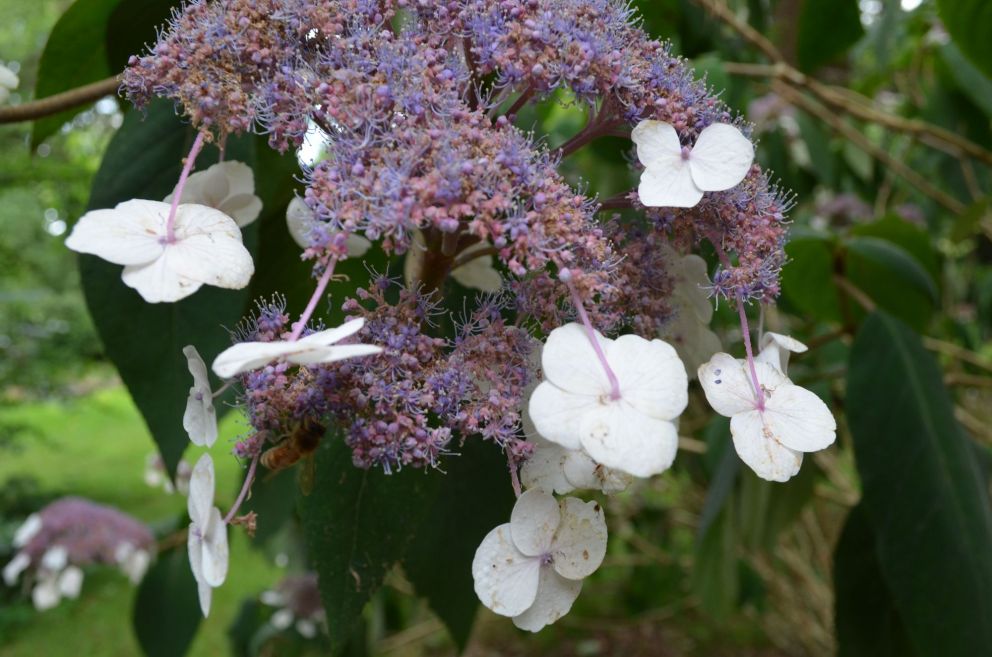
Hydrangea aspera ©TRP


